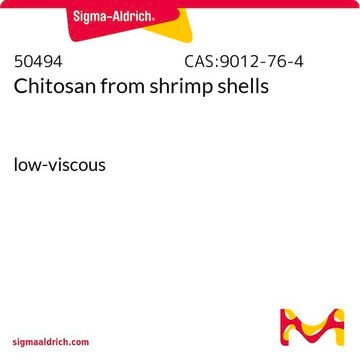The degree of acetylation should be above 75% for each lot, but the exact value will vary. For information on the degree of acetylation for a particular lot, contact the local technical service team.
48165
Chitosan from crab shells
highly viscous
Sinónimos:
2-Amino-2-deoxy-(1→4)-β-D-glucopyranan, Poly-(1,4-β-D-glucopyranosamine)
About This Item
Productos recomendados
origen biológico
(crab)
Formulario
powder
impurezas
≤1% insoluble matter
residuo de ign.
≤2% (as SO4)
pérdida
≤12% loss on drying
color
yellow
viscosidad
>400 mPa.s, 1 % in acetic acid(20 °C)
InChI
1S/C56H103N9O39/c1-87-56(86)65-28-38(84)46(19(10-74)96-55(28)104-45-18(9-73)95-49(27(64)37(45)83)97-39-12(3-67)88-47(85)20(57)31(39)77)103-54-26(63)36(82)44(17(8-72)94-54)102-53-25(62)35(81)43(16(7-71)93-53)101-52-24(61)34(80)42(15(6-70)92-52)100-51-23(60)33(79)41(14(5-69)91-51)99-50-22(59)32(78)40(13(4-68)90-50)98-48-21(58)30(76)29(75)11(2-66)89-48/h11-55,66-85H,2-10,57-64H2,1H3,(H,65,86)/t11-,12-,13-,14-,15-,16-,17-,18-,19-,20-,21-,22-,23-,24-,25-,26-,27-,28-,29-,30-,31-,32-,33-,34-,35-,36-,37-,38-,39-,40-,41-,42-,43-,44-,45-,46-,47-,48+,49+,50+,51+,52+,53+,54+,55+/m1/s1
Clave InChI
FLASNYPZGWUPSU-SICDJOISSA-N
¿Está buscando productos similares? Visita Guía de comparación de productos
Descripción general
Aplicación
Otras notas
Código de clase de almacenamiento
11 - Combustible Solids
Clase de riesgo para el agua (WGK)
nwg
Punto de inflamabilidad (°F)
Not applicable
Punto de inflamabilidad (°C)
Not applicable
Equipo de protección personal
Eyeshields, Gloves, type N95 (US)
Elija entre una de las versiones más recientes:
¿Ya tiene este producto?
Encuentre la documentación para los productos que ha comprado recientemente en la Biblioteca de documentos.
-
What is the degree of deacetylation of this reagent?
1 answer-
Helpful?
-
-
What is the molecular weight of this chitosan (ref 48165)?
1 answer-
The molecular weight for this product is not analyzed on a lot to lot basis. However, the expected range is 500,000 to 700,000 g/mol.
Helpful?
-
-
Greetings I wish to know if this chitosan is soluble or insoluble in water. I also realized that there is water-soluble chitosan. Please kindly clarify the difference. I need them to do laboratory experiments.
1 answer-
This product has not been tested for it's solubility in water. However, one gram chitosan can be dissolved in a mixture of 100mL 10% acetic acid and 50mL methanol, and then precipitated from a precipitant consisted of 10mL ethanol and 90mL acetate ester. The treated chitosan should become soluble in acid-free water completely at 8.02mg/mL
Helpful?
-
Active Filters
Nuestro equipo de científicos tiene experiencia en todas las áreas de investigación: Ciencias de la vida, Ciencia de los materiales, Síntesis química, Cromatografía, Analítica y muchas otras.
Póngase en contacto con el Servicio técnico



